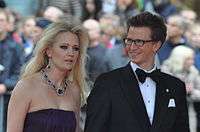Princess Anna of Bavaria
Princess Anna of Bavaria (German: Anna-Natascha Prinzessin von Bayern) (née; Princess Anna-Natascha zu Sayn-Wittgenstein-Berleburg; born 15 March 1978) is a German journalist and author. A member of the House of Sayn-Wittgenstein-Berleburg by birth, she became a member of the House of Wittelsbach in 2005 through her marriage to Prince Manuel of Bavaria.
| Princess Anna | |||||
|---|---|---|---|---|---|
 Princess Anna and her husband at the Wedding of Victoria, Crown Princess of Sweden, and Daniel Westling | |||||
| Born | 15 March 1978 Munich, Germany | ||||
| Spouse | Prince Manuel of Bavaria ( m. 2005) | ||||
| Issue | Prince Leopold Princess Alva Prince Gabriel | ||||
| |||||
| House | Sayn-Wittgenstein-Berleburg (by birth) Wittelsbach (by marriage) | ||||
| Father | Prince Ludwig Ferdinand of Sayn-Wittgenstein-Berleburg | ||||
| Mother | Countess Yvonne Wachtmeister af Johannishus | ||||
| Religion | Catholicism | ||||
| Occupation | journalist, writer | ||||
Early life
Princess Anna was born Princess Anna zu Sayn-Wittgenstein-Berleburg in Munich in 1978, the daughter of Prince Ludwig Ferdinand of Sayn-Wittgenstein-Berleburg and Countess Yvonne Wachtmeister af Johannishus. She has three siblings, including the actor Prince August Fredrik zu Sayn-Wittgenstein-Berleburg. Her paternal grandparents were Prince Ludwig Ferdinand of Sayn-Wittgenstein-Berleburg and Princess Friederike Juliane of Salm-Horstmar. She is the great-granddaughter of Richard, 4th Prince of Sayn-Wittgenstein-Berleburg and Princess Madeleine of Löwenstein-Wertheim-Freudenberg.
She graduated in History and Politics from Stanford University and with an MA in Creative Writing from the University of East Anglia.[1] She is political correspondent for Bild am Sonntag, having previously written for Die Welt. She has also written biographies of Karl-Theodor zu Guttenberg and Wolfgang Bosbach.
Marriage
On 6 August 2005 Princess Anna married Prince Manuel of Bavaria, the son of Prince Leopold of Bavaria and Ursula Möhlenkamp. The wedding took place in Stigtomta and Bärbo, small villages near Nyköping in Sweden. It was attended by more than 300 guests including King Carl XVI Gustaf of Sweden and his family.[2] The couple has three children together:
- Prince Leopold Maria Bengt Karl Manuel of Bavaria (b. 13 June 2007).
- Princess Alva Manuelle Maria Petra Yvonne of Bavaria (b. 5 January 2010).
- Prince Gabriel Maria Abraham Ludwig Theodor of Bavaria (b. 11 November 2014).
Honours

References
- "Anna von Bayern". Random House. Retrieved 13 April 2014.
- European Royal History Journal 2005: volume 8.4, page 19